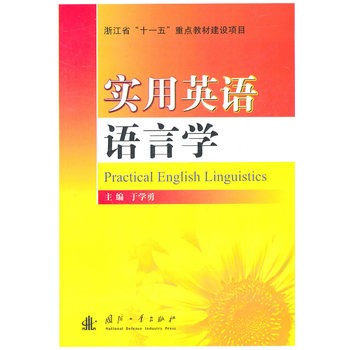《實用英語語言學》是2011年國防工業出版社出版的一本圖書,作者是於學勇。
基本介紹
- 書名:實用英語語言學
- 作者:於學勇
- ISBN:9787118075311
- 頁數:302頁
- 出版社:國防工業出版社
- 出版時間:2011年8月5日
- 裝幀:平裝
- 開本:32
- 版次:第1版
- 條形碼:9787118075311
- 尺寸:20.6 x 14.6 x 1.4 cm
- 重量:322 g
- ASIN:B005LKJHX0
編輯推薦,內容簡介,圖書目錄,
編輯推薦
此書活了二十多年也看了不少的書籍,唯有此書是一副我們心靈的靈丹妙藥,其他類的書籍可以不看,唯有此書一定要認真研讀,當建立了心理上的強大。
以基本概念為基礎,結合操作實例,深入淺出。在訓練內容上,結合教學和生產特點,在傳統實習內容的基礎上進行了適當的整合規劃,充實了新技術、新工藝的相關內容。
一直跟著此書作者討論,非常受益,值得認真看看,認真思考。此書雖然用的辭藻不華麗,但正因為這樣樸實的語句,更能為大眾所理解,所接受,作者將一部深奧難懂的精神分析學、社會關係學、等等,匯集到此書當中,用最親切的語言,最易於大眾理解的語言,一語道破天機。
內容簡介
《實用英語語言學》根據英語語言的層次性和邏輯性,全書共分九個章節講述英語語言學知識。《實用英語語言學》的編寫充分體現了語言學的基礎性、實用性、啟發性、自足性和時代性,重視語言學知識傳授與語言研究能力培養的結合,注重培養學生的創新思維能力,有利於學生語言學理論與語言實踐套用相結合。
圖書目錄
chapter 1 linguistics and language
1.1 what is linguistics?
1.1.1 definition of linguistics
1.1.2 the process of linguistic study
1.1.3 the scope of linguistics
1.1.4 important distinctions in linguistics
1.2 language
1.2.1 why study language?
1.2.2 what is language?
1.2.3 design features of language
1.2.4 functions of language
exercises
further reading
references
chapter 2 speech sounds
2.1 phonetics
2.1.1 what is phonetics?
2.1.2 speech organs
2.1.3 segments, divergences, and phonetic transcription
2.1.4 classification of english speech sounds
2.2 phonology
2.2.1 what is phonology?
2.2.2 phone, phoneme, and allophone
2.2.3 phonemic contrast, complementary distribution, and minimalpair
2.2.4 some rules in phonology
2.2.5 suprasegmental features
exercises
further reading
references
chapter 3 morphology
3.1 what is morphology?
3.1.1 morpheme
3.1.2 morphemes and syllables
3.1.3 types of morphemes
3.2 what is word?
3.2.1 word class
3.2.2 word formation process
3.2.3 collocation
exercises
further reading
references
chapter 4 syntax
4.1 what is syntax?
4.1.1 word-level categories
4.1.2 phrase categories
4.1.3 phrase structure rule
4.1.4 sentences (the s rule)
4.2 the process of syntax
4.2.1 the traditional approach
4.2.2 the structural approach
4.2.3 the generative approach
4.2.4 the functional approach
exercises
further reading
references
chapter 5 meaning
5.1 semantics
5.1.1 the study of meaning
5.1.2 major sense relations between words
5.1.3 major sense relations between sentences
5.1.4 analysis of meaning
5.2 pragmatics
5.2.1 what is pragmatics?
5.2.2 pragmatics vs.semantics
5.2.3 speech act theory
5.2.4 principle of conversation
5.2.5 conversational analysis
exercises
further reading
references
chapter 6 schools of modern linguistics
6.1 ferdinand de saussure
6.1.1 saussure and his book
6.1.2 saussure's linguistic theories
6.2 american structuralism
6.2.1 franz boas
6.2.2 edward sapir
6.2.3 leonard bloomfield
6.3 the prague school
6.3.1 phonological oppositions
6.3.2 functional sentence perspective (fsp)
6.4 the london school
6.4.1 malinowski's theories
6.4.2 firth's theories
6.4.3 halliday and systemic-functional grammar
6.5 noam chomsky and transformational-generative grammar
6.5.1 noam chomsky
6.5.2 chomsky's innateness hypothesis
6.5.3 transformational-generative grammar
6.6 cognitive linguistics
6.6.1 the nature of cognitive linguistics
6.6.2 cognitive semantics and cognitive approaches togrammar
exercises
further reading
references
chapter 7 language acquisition
7.1 first language acquisition
7.1.1 a behaviorist view of first language acquisition
7.1.2 a nativist view of first language acquisition
7.1.3 an interactionist view of first language acquisition
7.2 second language acquisition
7.2.1 contrastive analysis
7.2.2 error analysis
7.2.3 interlanguage
7.2.4 communicative competence
7.2.5 communication strategies in l2 use
7.2.6 individual learner differences
exercises
further reading
references
chapter 8 language and culture
8.1 what is culture?
8.1.1 definition
8.1.2 cultural images
8.1.3 functions and characteristics of culture
8.2 language and culture
8.2.1 the relation between language and culture
8.2.2 linguistic evidence of cultural differences
8.2.3 language-cultural teaching and learning
exercises
further reading
references
chapter 9 language and style
9.1 the definition of stylistics
9.2 the definition of style
9.2.1 style as the man
9.2.2 style as choice
9.2.3 style as deviation
9.2.4 style as foregrounding
9.3 deviation
9.3.1 phonological deviation
9.3.2 graphological deviation
9.3.3 lexical deviation
9.3.4 grammatical deviation
9.3.5 semantic deviation
9.4 overregularity
9.4.1 phonological overregularity
9.4.2 lexical and grammatical overregularity
exercises
further reading
references

